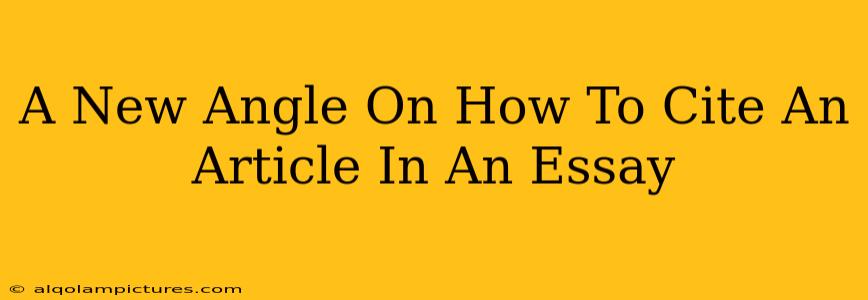Citing sources correctly is crucial for academic integrity and avoiding plagiarism. While the basics of citation might seem straightforward, mastering the art of seamless integration and accurate referencing elevates your essay from good to excellent. This post offers a fresh perspective on citing articles, focusing on effective strategies to enhance both the readability and credibility of your work.
Beyond the Basics: Why Proper Citation Matters
Before diving into the how, let's revisit the why. Proper citation isn't just about avoiding academic penalties; it's about:
- Building credibility: Supporting your arguments with reliable sources demonstrates your research diligence and strengthens your overall claim.
- Giving credit where it's due: Respecting intellectual property is paramount in academia and beyond.
- Enhancing readability: Well-integrated citations flow naturally with your writing, avoiding disruptive interruptions to the reader's flow.
- Improving SEO: Using keywords appropriately within the context of your citations can inadvertently boost your document's search engine optimization, making it easier for others to find your work.
Mastering Different Citation Styles: APA, MLA, Chicago, and More
Different academic disciplines favor different citation styles. The most common include:
- APA (American Psychological Association): Widely used in social sciences, psychology, and education. Focuses on author-date referencing.
- MLA (Modern Language Association): Commonly used in humanities disciplines like literature, languages, and cultural studies. Emphasizes author-page number referencing.
- Chicago/Turabian: Used across a broader range of disciplines and offers both author-date and notes-bibliography systems.
Choosing the right style is critical. Your instructor or institution will specify the required style, so always check before you begin writing.
Key Elements of a Citation: Regardless of Style
While the formatting varies, most citation styles require similar core information:
- Author(s): Last name, first initial (and middle initial if available).
- Date of Publication: Year of publication.
- Article Title: In quotation marks.
- Journal/Publication Title: In italics.
- Volume and Issue Number (if applicable): Often included in journal articles.
- Page Numbers: The range of pages where the article appears.
- DOI (Digital Object Identifier) or URL: Provides a persistent link to the article.
Seamless Integration: Show, Don't Just Tell
Simply listing citations at the end isn't enough. You need to integrate them smoothly within your text. Here are some effective techniques:
Signal Phrases:
Introduce your citations with phrases like:
- "According to Smith (2023),"
- "As Jones et al. (2022) argue,"
- "Research by Brown (2021) suggests..."
These phrases create a natural transition and clearly attribute the information to its source.
Paraphrasing and Summarizing:
Don't just copy and paste! Paraphrase and summarize the key information in your own words, then cite the original source. This demonstrates your understanding of the material.
Direct Quotes:
Use direct quotes sparingly, only when the author's words are particularly impactful or insightful. Always enclose the quote in quotation marks and provide a page number.
Leveraging Citations for SEO: Keyword Integration
While not the primary focus of citation, strategically using relevant keywords within your citations can subtly boost SEO. For instance, if your article focuses on "climate change mitigation strategies," incorporating this keyword phrase naturally within your citations when discussing relevant research can be beneficial. However, remember to prioritize accuracy and clarity over keyword stuffing.
Conclusion: Cite with Confidence
Mastering the art of citing articles is an essential skill for any academic writer. By understanding the various citation styles, integrating sources seamlessly, and paying attention to detail, you can create essays that are both credible and engaging. Remember, proper citation is not just a requirement; it is a hallmark of quality scholarship.

